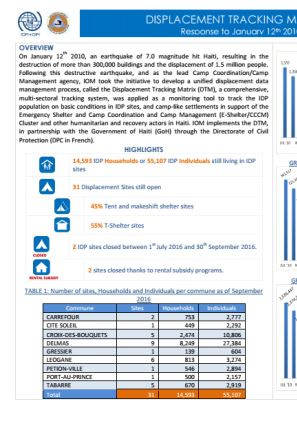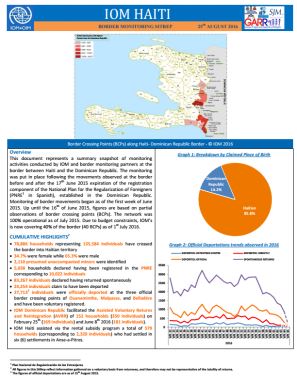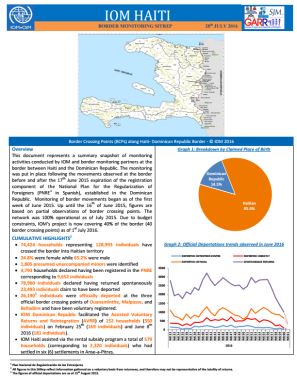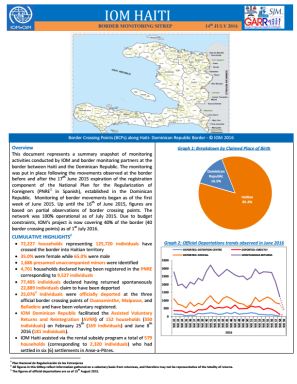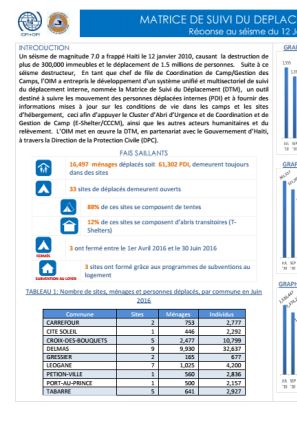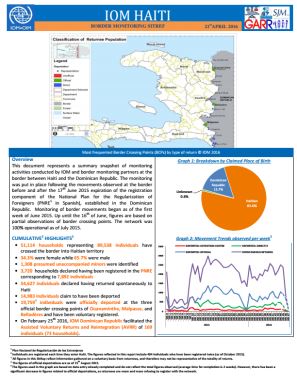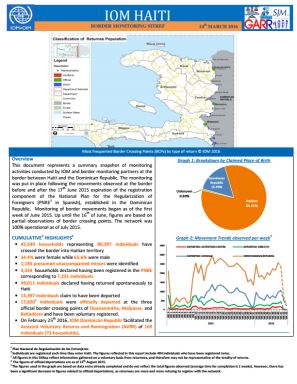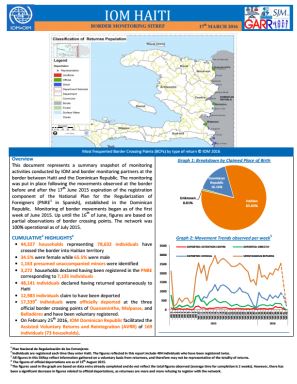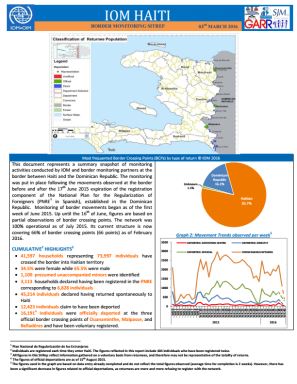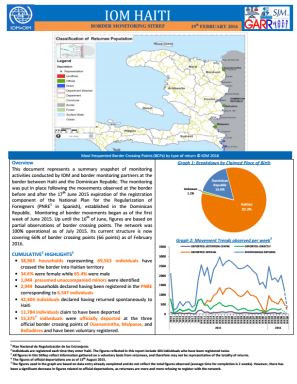-
Countries
-
Data and Analysis
-
Special Focus
-
Crisis Responses
Haiti
IDPs tracked
Displacement Movements
311,000
IDMC 2023
Data collection round
About Haiti
On January 12th 2010, an earthquake of 7.0 magnitude hit Haiti, resulting in the destruction of more than 300,000 buildings and the displacement of 1.5 million people. Following this destructive earthquake, and as the lead Camp Coordination/Camp Management agency, IOM took the initiative to develop a unified displacement data management process, called the Displacement Tracking Matrix (DTM). A comprehensive multi-sectoral tracking system was applied as a monitoring tool to track the IDP population on basic conditions in IDP sites, and camp-like settlements in support of the Emergency Shelter and Camp Coordination and Camp Management (E-Shelter/CCCM) Cluster and other humanitarian and recovery actors in Haiti. IOM implements the DTM in partnership with the Government of Haiti (GoH) through the Directorate of Civil Protection (DPC in French).
DTM has been adapted to the new context in the country to track humane mobility including displacement induced by gangs violence, forced returns of Haitians, migration with country in the region, especially with the Dominican Republic.
Current Donors
- CERF
- USAID
- BHA
- ECHO
- Canada
Haiti — Earthquake Displacement Report 27 (September 2016)
More than 5 years after the devastating 12 January 2010 earthquake, an estimated 14,593 households, or 55,107 individuals are still residing in 31 IDP sites in the earthquake affected communes.
Haiti — Border Monitoring Situation Report (29 September 2016)
Cumulatively since the first week of June 2015 to 29 September 2016, 84,405 households representing 143,094 individuals have crossed the border into Haitian territory. 34.3% were female while 65.7% were male. 2,273 presumed unaccompanied minors were identified.
Haiti — Border Monitoring Situation Report (22 September 2016)
Cumulatively from the first week of June 2015 to 22 September 2016, 83,195 households representing 141,506 individuals have crossed the border into Haitian territory. 34.4% were female while 65.6% were male. 2,244 presumed unaccompanied minors were identified.
Haiti — Border Monitoring Situation Report (25 August 2016)
Cumulatively from the first week of June 2015 to 25 August 2016, 135,584 individuals have crossed the border into Haitian territory. 34.7% were female while 65.3% were male and 2,110 presumed unaccompanied minors were identified.
Haiti — Border Monitoring Situation Report (28 July 2016)
Cumulatively from the first week of June 2015 to 28 July 2016, 74,424 households representing 128,993 individuals have crossed the border into Haitian territory. 34.8% were female while 65.2% were male. 1,805 presumed unaccompanied minors were identified.
Haiti — Border Monitoring Situation Report (14 July 2016)
Cumulatively since the first week of June 2015 to 14 July 2016, 72,227 households representing 125,720 individuals have crossed the border into Haitian territory. 35.0% were female while 65.0% were male. 1,686 presumed unaccompanied minors were identified.
Haiti — Border Monitoring Situation Report (7 July 2016)
Cumulatively from the first week of 2015 to 7 July 2016, 70,556 households representing 123,353 individuals have crossed the border into Haitian territory. 35.0% were female while 65.0% were male. 1,686 presumed unaccompanied minors were identified.
Haiti — Border Monitoring Situation Report (30 June 2016)
Cumulatively from the first week of June 2015 to 30 June 2016, 68,933 households representing 120,646 individuals have crossed the border into Haitian territory. 35.0% were female while 65.0% were male. 1,641 presumed unaccompanied minors were identified.
Haiti — Earthquake Displacement Report 26 (June 2016)
More than 5 years after the devastating 12 January 2010 earthquake, an estimated 16,497 households, or 61,302 individuals are still residing in 33 IDP sites in the earthquake affected communes.
Haiti — Rapport de déplacement — Séisme 26 (Juin 2016)
Un séisme de magnitude 7.0 a frappé Haiti le 12 janvier 2010. Celui-ci a causé la destruction de plus de 300,000 immeubles et le déplacement de 1.5 millions de personnes. Le rapport suivant présente le
Haiti — Border Monitoring Situation Report (16 June 2016)
Cumulatively from the first week of June 2015 to 16 June 2016, 65,686 households representing 115,586 individuals have crossed the border into Haitian territory. 35.1% were female while 64.9% were male. 1,580 presumed unaccompanied minors were identified.
Haiti — Border Monitoring Situation Report (2 June 2016)
Cumulatively from the first week of June 2015 to 2 June 2016, 62,180 households representing 109,783 individuals have crossed the border into Haitian territory. 35.1% were female while 64.9% were male. 1,516 presumed unaccompanied minors were identified.
Haiti — Border Monitoring Situation Report (2 June 2016)
Cumulatively from the first week of June 2015 to 2 June 2016, 62,180 households representing 109,783 individuals have crossed the border into Haitian territory. 35.1% were female while 64.9% were male. 1,516 presumed unaccompanied minors were identified.
Haiti — Border Monitoring Situation Report (12 May 2016)
Cumulatively from the first week of June 2015 to 12 May 2016, 58,078 households representing 102,214 individuals have crossed the border into Haitian territory. 34.9% were female while 65.1% were male. 1,448 presumed unaccompanied minors were identified.
Haiti — Border Monitoring Situation Report (5 May 2016)
Cumulatively from the first week of June 2015 to 5 May 2016, 56,859 households representing 99,919 individuals have crossed the border into Haitian territory. 34.7% were female while 65.3% were male. 1,403 presumed unaccompanied minors were identified.
Haiti — Border Monitoring Situation Report (21 April 2016)
Cumulatively from the first week of June 2015 to 21 April 2016, 51,114 households representing 89,538 individuals have crossed the border into Haitian territory. 34.3% were female while 65.7% were male. 1,308 presumed unaccompanied minors were identified.
Haiti — Earthquake Displacement Report 25 (March 2016)
More than 5 years after the devastating 12 January 2010 earthquake, an estimated 17,119 households, or 62,590 individuals are still residing in 36 IDP sites in the earthquake affected communes.
Haiti — Border Monitoring Situation Report (24 March 2016)
Cumulatively since the first week of June 2015 until 24 March 2016, 45,549 households representing 80,397 individuals have crossed the border into Haitian territory. 34.4% were female while 65.6% were male. 1,185 presumed unaccompanied minors were identified.
Haiti — Border Monitoring Situation Report (17 March 2016)
Cumulatively since the first week of June 2015, 44,327 households representing 78,632 individuals have crossed the border into Haitian territory. 34.5% were female while 65.5% were male. 1,163 presumed unaccompanied minors were identified.
Haiti — Border Monitoring Situation Report (3 March 2016)
Cumulatively from the first week of June 2015 to 3 March 2016, 41,597 households representing 73,997 individuals have crossed the border into Haitian territory. 34.5% were female while 65.5% were male. 1,100 presumed unaccompanied minors were identified.
Haiti — Border Monitoring Situation Report (19 February 2016)
Cumulatively from the first week of June 2015 to 19 February 2016, 38,963 households representing 69,563 individuals have crossed the border into Haitian territory. 34.6% were female while 65.4% were male. 1,044 presumed unaccompanied minors were identified.
Haiti — Border Monitoring Situation Report (12 February 2016)
Cumulatively from the first week of June 2015 to 12 February 2016, 37,806 households representing 67,685 individuals have crossed the border into Haitian territory. 34.7% were female while 65.3% were male. 1,011 presumed unaccompanied minors were identified.
Haiti — Border Monitoring Situation Report (22 January 2016)
Cumulative from the first week of June 2015 to 22 January 2016, 34,624 households representing 62,420 individuals have crossed the border into Haitian territory. 34.9% were female while 65.1% were male. 970 presumed unaccompanied minors were identified.
Haiti — Rapport de déplacement — Séisme 24 (Décembre 2015)
Un séisme de magnitude 7.0 a frappé Haiti le 12 janvier 2010. Celui-ci a causé la destruction de plus de 300,000 immeubles et le déplacement de 1.5 millions de personnes. Le rapport suivant présente le
Pagination
Pagination
- First page
- Previous page
- 1
- 2
- 3
- 4
- 5
- 6
- 7
- 8


